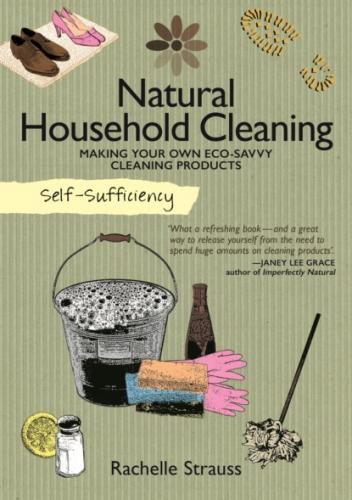Does formaldehyde harm the environment?
Formaldehyde is one of the large family of chemical compounds called volatile organic compounds (VOCs) which you’ll learn more about in the following chapters. Levels of formaldehyde emitted from products increase with temperature and humidity, so bear this in mind if you use a disinfectant or floor cleaner containing formaldehyde that you add to a bucket of hot water.
Fragrance
Which products contain fragrance?
Nearly every cleaning product is scented. Most fragrances or ‘parfums’ are made from a cocktail of petrochemicals. Several thousand different chemicals can make up one fragrance and manufacturers do not have to disclose what ingredients they use.
Can fragrances harm me?
If you react badly to the smell of a product, then listen to the warning your body is giving you! If you find yourself with itchy eyes or a tickly throat as you walk down the cleaning aisle of your supermarket, then maybe you’ll begin to understand how some of these products are affecting your health. Inhalation of fragranced products can cause immediate symptoms such as sneezing, itchy eyes, headaches, nausea and wheezing. More chronic symptoms from exposure to artificial fragrances include asthma, multiple chemical sensitivity, lethargy and short-term memory loss.
How else can I be affected by fragrances?
Fragrances don’t just enter your body through the nose.
They are also absorbed through the skin. Two products that are notorious for causing skin irritation are laundry detergents and fabric conditioners (softeners). Both are highly scented and residues of the chemicals used to make the fragrance are against your skin all day in the clothes you wear.
Fragrances serve no useful purpose in a product in that they do not make them more effective. They are there to ‘brand’ a product and cover up some of the terrible smells of the raw ingredients. Fragrances are designed to linger – on your clothes, bedding and in the air of your home – so you are constantly in contact with them.
Triclosan
Which products contain triclosan?
Triclosan is one of the most widely used antibacterial and antifungal ingredients in household cleaners and personal care products. You will find it in some hand- or dish-washing soaps and even impregnated into surfaces such as food storage boxes and ‘antibacterial’ chopping boards.
Can triclosan harm me?
Once touted a ‘cure all’ for germs and bacteria everywhere, there is now concern about the dangerous consequences of triclosan when it is absorbed through the skin and accumulates in the body. Triclosan has been found accumulated in fish tissue and human breast milk. One of the most devastating side effects of the overuse of antibacterial products is that resistant strains of bacteria are developing all the time. This means that bacteria that were once killed by triclosan have found ways to mutate and survive in much the same way as some ‘superbugs’ are now resistant to antibiotics.
How else can I be affected by triclosan?
Research shows that when triclosan meets with free chlorine in tap water it produces a number of toxic products such as 2,4-dichlorophenol. In the presence of sunlight, these products can produce dioxins. Some dioxins are extremely toxic and are potent endocrine disruptors.
Reports have suggested that triclosan can combine with chlorine in tap water to form chloroform gas, which the United States Environmental Protection Agency classifies as a probable human carcinogen. Scientists are concerned that if you use a product containing triclosan, such as antibacterial soap, and then jump into a chlorinated swimming pool, it could produce dioxin on the surface of your skin that then gets absorbed into your body.
Volatile organic compounds (VOCs)
Which products contain VOCs?
Many liquid cleaners and household products contain organic solvents such as ethanol, methanol, isopropyl alcohol, propylene glycol, and glycol ethers. These solvents release volatile organic vapours into the air.
Can VOCs harm me?
Products that are sprayed from aerosol cans or pump sprays usually contain VOCs. Used in this way, VOCs become small particles that are easily inhaled and contribute to increased levels of ground-level ozone. These fumes can cause intoxication, drowsiness, breathing difficulties, asthma attacks, disorientation and headaches. Long-term exposure to some organic solvents can damage the nervous system and may be carcinogenic. Many solvents can be skin and eye irritants; others produce vapours that can be flammable. If you see the term ‘volatile’ on a label, ventilating the area you are working in is crucial to reduce harmful inhalation. Volatile compounds also release vapours slowly while being stored, thus creating toxins in the air of your home on a constant basis.
How do I know there are VOCs in my home?
You can usually smell VOCs easily – artificial fragrances contain VOCs – and the strong scents that come from many products such as glass cleaners are VOCs escaping from the product into the air of your home. Ironically, it is often the smell of VOCs that we associate with a ‘fresh smell’ in our homes. We feel certain that our homes are clean if they have this familiar scent. VOCs are also present in plug-ins and spray air fresheners.
Now that you are fully versed in the nasty chemicals that lurk in shop-bought cleaning products, let’s learn about some safer alternatives.
Конец ознакомительного фрагмента.
Текст предоставлен ООО «ЛитРес».
Прочитайте эту книгу целиком, купив полную легальную версию на ЛитРес.
Безопасно оплатить книгу можно банковской картой Visa, MasterCard, Maestro, со счета мобильного телефона, с платежного терминала, в салоне МТС или Связной, через PayPal, WebMoney, Яндекс.Деньги, QIWI Кошелек, бонусными картами или
